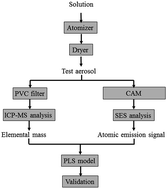当前位置:
X-MOL 学术
›
J. Anal. At. Spectrom.
›
论文详情
Our official English website, www.x-mol.net, welcomes your feedback! (Note: you will need to create a separate account there.)
Calibration approaches for the measurement of aerosol multielemental concentration using spark emission spectroscopy†
Journal of Analytical Atomic Spectrometry ( IF 3.4 ) Pub Date : 2018-02-02 00:00:00 , DOI: 10.1039/c7ja00252a L Zheng 1, 2 , P Kulkarni 1 , D D Dionysiou 2
Journal of Analytical Atomic Spectrometry ( IF 3.4 ) Pub Date : 2018-02-02 00:00:00 , DOI: 10.1039/c7ja00252a L Zheng 1, 2 , P Kulkarni 1 , D D Dionysiou 2
Affiliation

|
A multivariate calibration approach, using partial least squares regression, has been developed for the measurement of aerosol elemental concentration. A training set consisting of 25 orthogonal aerosol samples with 9 factors (elements: Cr, Mn, Fe, Ni, Cu, Zn, Cd, Pb, and Ti) and 5 levels (elemental concentrations) was designed. Spectral information was obtained for each aerosol sample using aerosol spark emission spectroscopy (ASES) at a time resolution of 1 minute. Simultaneously, filter samples were collected for the determination of elemental concentration using an inductively coupled plasma mass spectrometry (ICP-MS) analysis. Two regression models, PLS1 and PLS2, were developed to predict mass concentration from spectral measurements. The prediction ability of the models improved substantially when only signature wavelengths were included instead of the entire spectrum. The PLS1 model with 45 selected spectral variables (PLS1-45 model) presented the lowest relative root mean square error of cross validation (RMSECV; 16–35%). The detection limits using the PLS1-45 model for the nine elements were in the range of 0.16–0.50 μg m−3. The performance of both multivariate and univariate regression models was tested for an unknown sample of welding fume aerosol. The multivariate model did not provide significantly better prediction compared to the univariate model. In spite of the difference in the matrices of the calibration aerosol and the unknown test aerosol, the results from the PLS model show good agreement with those from filter measurements. The relative root mean square error of prediction (RMSEP) obtained from the PLS1-45 model was 13% for Cr, 23% for Fe, 22% for Mn and 12% for Ni. The study shows that in spite of lower spectral resolution and lack of sample preparation, reliable and robust measurements can be obtained using the proposed calibration method based on PLS regression.
中文翻译:

使用火花发射光谱法测量气溶胶多元素浓度的校准方法†
已经开发了一种使用偏最小二乘回归的多变量校准方法,用于测量气溶胶元素浓度。设计了一个由 9 个因子(元素:Cr、Mn、Fe、Ni、Cu、Zn、Cd、Pb 和 Ti)和 5 个水平(元素浓度)的 25 个正交气溶胶样品组成的训练集。使用气溶胶火花发射光谱 (ASES) 以 1 分钟的时间分辨率获得每个气溶胶样品的光谱信息。同时,收集过滤器样品用于使用电感耦合等离子体质谱 (ICP-MS) 分析测定元素浓度。开发了两个回归模型 PLS1 和 PLS2 来从光谱测量中预测质量浓度。当只包括特征波长而不是整个光谱时,模型的预测能力显着提高。具有 45 个选定光谱变量的 PLS1 模型(PLS1-45 模型)呈现出最低的交叉验证相对均方根误差(RMSECV;16-35%)。使用 PLS1-45 模型对九种元素的检测限在 0.16–0.50 μg m-3。多变量和单变量回归模型的性能都针对未知的焊接烟雾气溶胶样本进行了测试。与单变量模型相比,多变量模型没有提供明显更好的预测。尽管校准气溶胶和未知测试气溶胶的矩阵存在差异,但 PLS 模型的结果与过滤器测量的结果非常吻合。从 PLS1-45 模型获得的预测的相对均方根误差 (RMSEP) 为 Cr 为 13%,Fe 为 23%,Mn 为 22%,Ni 为 12%。研究表明,尽管光谱分辨率较低且缺乏样品制备,但使用所提出的基于 PLS 回归的校准方法可以获得可靠和稳健的测量结果。
更新日期:2018-02-02
中文翻译:

使用火花发射光谱法测量气溶胶多元素浓度的校准方法†
已经开发了一种使用偏最小二乘回归的多变量校准方法,用于测量气溶胶元素浓度。设计了一个由 9 个因子(元素:Cr、Mn、Fe、Ni、Cu、Zn、Cd、Pb 和 Ti)和 5 个水平(元素浓度)的 25 个正交气溶胶样品组成的训练集。使用气溶胶火花发射光谱 (ASES) 以 1 分钟的时间分辨率获得每个气溶胶样品的光谱信息。同时,收集过滤器样品用于使用电感耦合等离子体质谱 (ICP-MS) 分析测定元素浓度。开发了两个回归模型 PLS1 和 PLS2 来从光谱测量中预测质量浓度。当只包括特征波长而不是整个光谱时,模型的预测能力显着提高。具有 45 个选定光谱变量的 PLS1 模型(PLS1-45 模型)呈现出最低的交叉验证相对均方根误差(RMSECV;16-35%)。使用 PLS1-45 模型对九种元素的检测限在 0.16–0.50 μg m-3。多变量和单变量回归模型的性能都针对未知的焊接烟雾气溶胶样本进行了测试。与单变量模型相比,多变量模型没有提供明显更好的预测。尽管校准气溶胶和未知测试气溶胶的矩阵存在差异,但 PLS 模型的结果与过滤器测量的结果非常吻合。从 PLS1-45 模型获得的预测的相对均方根误差 (RMSEP) 为 Cr 为 13%,Fe 为 23%,Mn 为 22%,Ni 为 12%。研究表明,尽管光谱分辨率较低且缺乏样品制备,但使用所提出的基于 PLS 回归的校准方法可以获得可靠和稳健的测量结果。


























 京公网安备 11010802027423号
京公网安备 11010802027423号